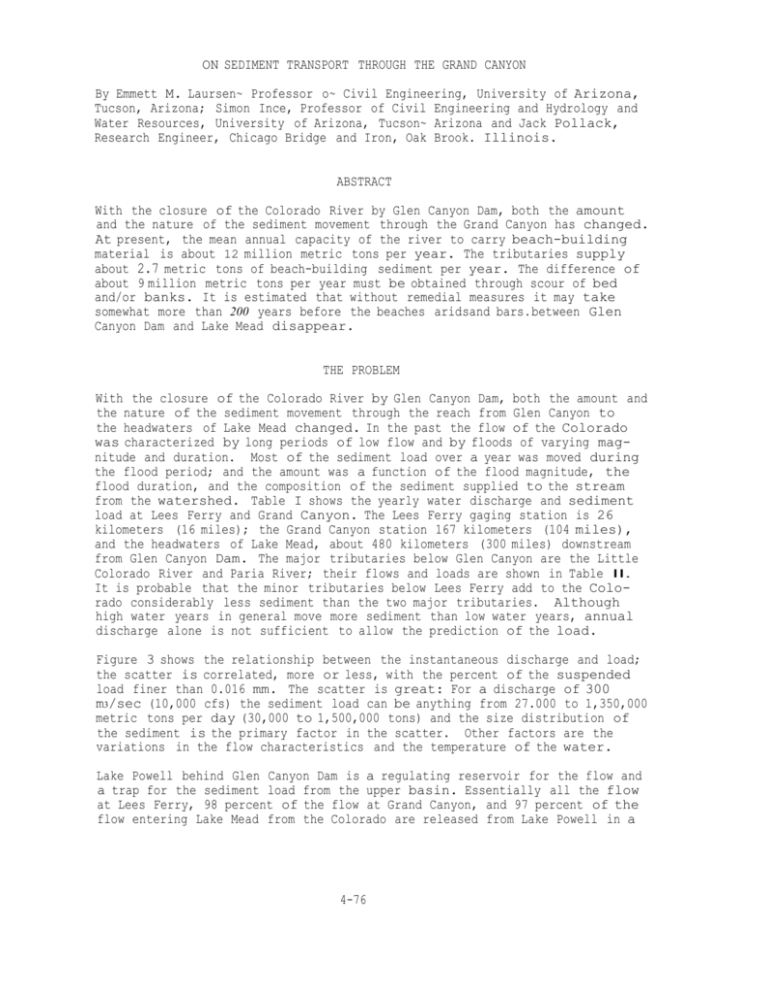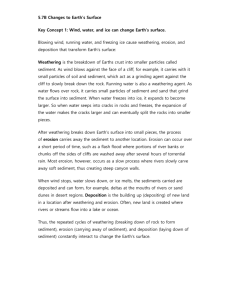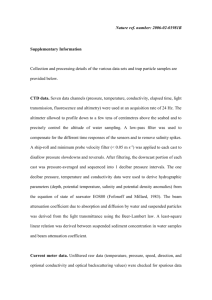ON SEDIMENT TRANSPORT THROUGH THE GRAND CANYON By
advertisement

ON SEDIMENT TRANSPORT THROUGH THE GRAND CANYON
By Emmett M. Laursen~ Professor o~ Civil Engineering, University of Arizona,
Tucson, Arizona; Simon Ince, Professor of Civil Engineering and Hydrology and
Water Resources, University of Arizona, Tucson~ Arizona and Jack Pollack,
Research Engineer, Chicago Bridge and Iron, Oak Brook. Illinois.
ABSTRACT
With the closure of the Colorado River by Glen Canyon Dam, both the amount
and the nature of the sediment movement through the Grand Canyon has changed.
At present, the mean annual capacity of the river to carry beach-building
material is about 12 million metric tons per year. The tributaries supply
about 2.7 metric tons of beach-building sediment per year. The difference of
about 9 million metric tons per year must be obtained through scour of bed
and/or banks. It is estimated that without remedial measures it may take
somewhat more than 200 years before the beaches aridsand bars.between Glen
Canyon Dam and Lake Mead disappear.
THE PROBLEM
With the closure of the Colorado River by Glen Canyon Dam, both the amount and
the nature of the sediment movement through the reach from Glen Canyon to
the headwaters of Lake Mead changed. In the past the flow of the Colorado
was characterized by long periods of low flow and by floods of varying magnitude and duration. Most of the sediment load over a year was moved during
the flood period; and the amount was a function of the flood magnitude, the
flood duration, and the composition of the sediment supplied to the stream
from the watershed. Table I shows the yearly water discharge and sediment
load at Lees Ferry and Grand Canyon. The Lees Ferry gaging station is 26
kilometers (16 miles); the Grand Canyon station 167 kilometers (104 miles),
and the headwaters of Lake Mead, about 480 kilometers (300 miles) downstream
from Glen Canyon Dam. The major tributaries below Glen Canyon are the Little
Colorado River and Paria River; their flows and loads are shown in Table II.
It is probable that the minor tributaries below Lees Ferry add to the Colorado considerably less sediment than the two major tributaries. Although
high water years in general move more sediment than low water years, annual
discharge alone is not sufficient to allow the prediction of the load.
Figure 3 shows the relationship between the instantaneous discharge and load;
the scatter is correlated, more or less, with the percent of the suspended
load finer than 0.016 mm. The scatter is great: For a discharge of 300
m3/sec (10,000 cfs) the sediment load can be anything from 27.000 to 1,350,000
metric tons per day (30,000 to 1,500,000 tons) and the size distribution of
the sediment is the primary factor in the scatter. Other factors are the
variations in the flow characteristics and the temperature of the water.
Lake Powell behind Glen Canyon Dam is a regulating reservoir for the flow and
a trap for the sediment load from the upper basin. Essentially all the flow
at Lees Ferry, 98 percent of the flow at Grand Canyon, and 97 percent of the
flow entering Lake Mead from the Colorado are released from Lake Powell in a
4-76
TABLE I
Measured Yearly Discharge and Sediment Load
of the Colorado River at Lees Ferry and Near Grand Canyon
LEES FERRY
'Water
Year
1948
1949
1950
1951
1952
1953
1954
1955
1956
1957
1958
1959
1960
1961
1962
196,?
1964
1965
1966
1967
GRA.~l) CANYON
Average
Discharge.
Cubic Meters
per Second
Suspended
Sediment
Million
Metric Tons
Average
Discharge
Cubic Meters
per Second
534
99.5
542
560
432
384
703
344
239
285
342
677
565
264
359
260
577
98
95
424
87.8
48.5
43.4
104.0
37.6
31.3
561
433
385
710
347
244
52.S
46.0
347
102.0
14.4
272
109.0
25.4
35.8
56.7
14.0
4.0
5.4
296
685
570
374
275
595
107
106
108.0
54.1
44.1
135.6
44.2
37.0
75.5
69.0*
141.0
120.0*
22.2*
36.0
42.5
77 .5
18.3
18.5
36.0
326
8.2
21.2
14.8
13.1
350
464
1969
131.0
430
323
1968
Suspended
Sediment
Million
Metric Tons
* Estimated
regulated, non-natural pattern. Since Lake Powell traps all the sediment delivered to it, very little sediment is now supplied to the river between Glen
Canyon Dam and Lees Ferry. The small sediment load moving past Lees Ferry
now is cOming largely from the bed and banks in the reach between Glen Canyon
Dam and Lees Ferry. Eventually the flow past Lees Ferry will be almost always clear, as the bed, banks and beaches are swept away or gradually armored
through self sorting, leaving a natural riprap protecting the surface.
Because the sediment supplied to the flow past Lees Ferry most of the time
will be zero, there will be general degradation in·the reach above; and it is
4-77
TABLE II
Measured Yearly Discharge and Sediment Load of the Paria River
at Lees Ferry and the Little Colorado River Near Cameron
PARIA RIVER AT
LEES FERRY
Water
Year
Average
Discharge
Cubic Meters
per Second
1948
1949
0.75
0.77
1950
1951
1952
1953
1954
1955
1956
1957
1958
1959
1960
1961
1962
1963
1964
1965
1966
1967
1968
1969
0.53
0.54
0.74
0.70
0.61
0.69
0.39
0.65
1.54
0.54
0.41
1.21
0.59
0.78
0.52
0.60
0.63
1.02
0.93
1.04
LITTLE COLORADO
NEAR CAMERON
Suspended
Sediment
Million
Metric Tons
Average
Discharge
Cubic Meters
per Second
7.86
1.96
1.31
1.38
1.80
4.14
2.09
3.92
0.95
2.91
10.20
2.52
0.37
11.80
1.89
5.40
1.15
1.23
1.22
5.15
6.21
3.50
11.22
1.84
1.96
13.77
2.40
4.25
7.65
0.76
6.85
6.55
2.01
7.59
L51
6.17
3.30
6.69
8.82
7.92
7.45
8.35
5.46
Suspended
Sediment
Million
Metric Tons
4.03
12.95
2.92
4.51
17.30
3.77
8.24
20.20
1.83
9.93
10.40
6.21
8.01
3.18
5.31
9.82
.15.58
8.76
9.59
17.31
8.64
7.81
the competence rather than the capacity of the stream, in respect to sediment
movement, which is of interest. In the next reach down to Grand Canyon it is
the comparison between capacity to transport sediment and sediment supplied
by the tributaries which is of interest. If the capacity exceeds the supply,
there will be general degradation and a tendency to enlarge the stream until
the reduced capacity equ&ls the supply. If the supply should exceed the
capacity, there will be a tendency to aggrade until a smaller, swifter stream
is formed with a capacity equal to the.supply. In the reach below Grand
Canyon and above Lake Head there should be a smalle.r tendency to degrade,
mainly because the attenuation of the surges in the.releases from Glen Canyon reduces the capacity to transport.
4-78
THE ANALYSIS
In order to explain the variability of the sediment load, a sediment-transport
relationship was needed which would predict the sediment concentration and
composition as a function of the flow, the cross section of the stream, and
the composition of the bed material. For obvious reasons - nepotism and
solidarity - the Laursen relationship was chosen (Laursen, 1958). Zernial
has demonstrated that this relationship is capable of explaining the commonly
encountered scatter of the sediment load versus discharge plot (Zernial, 1963).
In applying the relationship to the gaging stations at Lees Ferry and Grand
Canyon, the cross section was divided up as it was when gaged by the U.S.
Geological Survey; and the measured depth and velocity for each subsection
were used in the computations. The temperature was always assumed to be
11°C (5l.8°F), and the fall velocity of the sediment was taken as that of a
quartz sphere. The slope at Lees Ferry was taken as 0.00028 and the slope at
Grand Canyon as 0.00063. The sediment load of the subsections was combined
for a value for the entire section. Using the measured bed material samples,
the concentration computed was less than the measured suspended load concentration, and the composition of the computed suspended sediment was coarser
than that measured.
It is very difficult to obtain a true bed material sample; the presence of
the sampler near the bottom can cause high velocities at the bed which remove the fine particles before the sampler can take the sample. Therefore,
small amounts of fines were arbitrarily added to the measured bed material
and the computations were repeated. Reasonably close agreement was then
achieved for both the concentration and composition of the suspended load.
Since the suspension tended to be largely fine material not found in the bed
material samples, it was concluded that the imagined bed material was closer
to correct and that the Laursen relationships would probably describe the
sediment-transporting characteristics of the stream reasonably well.
As is shown in Figure 1, the size composition of the beach material collected
during a reconnaissance trip down the Colorado River by the principal investigators was remarkably constant all the way from Lees Ferry to Diamond
Creek. Several bottom samples obtained during the same trip were also quite
uniform as shown in Figure 2. Although the bed material samples were obtained with a crude grab bucket, they gave a computed suspended sediment
composition which could explain that of the beach material, and computed
sediment loads along the low side of the scatter band of measured sediment
load and discharge (Figure 3). The scatter of the computed points in Figure
3 is the result of channel instability in that actual velocities and depths
were used from stream gaging records.
The computed beach-building suspended sediment load has a somewhat greater
range of size variation than the beach sand, which is to be expected. The
coarser fractions of the suspended load are in greater concentration near the
bed than up toward the water surface; thus the coarser material tends not to
be supplied to the deposition area of the beach. TI1efiner fraction of the
suspended load, on the other hand, does not tend as much to deposit in the
eddy and is swept on away. Thus, it is the middle fraction of the suspended
load which builds the beaches.
4-79
! LEES
! NhL.~.
f~f\RY
0
o~----~
\ly'Z..
~O-I
10-1..
\DCt-----.,...---
-
;
!
j-----If-
I\------f'+_
I
11Y\\L\2 11
M\L~ 9e,
I
~
III
0
~~l ./=----LI.
.c'-Z
\0-\ 10-2
3 \M r-------t----::~--,
fa
~
I.1J
:Z
i[
F\G'.JRt: I.
CO~~OS r\\O~
o~~~~~--------~
lO~2.
PA\{ltGLE
iO-\
\
O\Ahi\E\ER (rnm)
4-80
Of 8EAC\-\ SMOS
MlLE \8
1":!'
-
<.D
III
.~
r
C!J
to-1_.
~
UJ
'"£
-
tOt>
r
£.L,
1T'1\)\C/-\L
f-
'G~D MI-\TER,\I\L
."'Z
...-
~
a;
l.u
Q..
O~--
~
-4
\0'-\
to
Straight lines were put through the computed beach-building sediment load
points by eye in Figure 3, with some attention to the edge of the scatter
band of the measured values. These relationships were then used to compute
the annual beach-building sediment load past Lees Ferry and Grand Canyon as
shown in Table III in which the annual load is the summation of the daily loads
through the water year. In years without a large magnitude flood the load of
beach-building material past Lees Ferry was greater than the load past Grand
Canyon indicating that there was deposition between the two stations. However, over the 15 years used in the calculations, the amount of beach-building
4-81
r
I
k6~q;o8
IJ
r
- 00
....
•
-~
~
Iv
ro
O(
~
.~
•
00
~
l.<'r
.~
,
•
~
---.
f'I~
V
06>
-.- -.-
0
1-----0
IU
IV
19
n ....,
0
~
.
00 00
0
Pn
0
0
0
• CCM?UTE!)
o Mtp,:S\.)~tD
~MuS6S
--V-i---o---
I
i
j
~~o
"
~
V•
~
!
~
t?
0
0
,•
_JI"
---.-.-----
.- .....
~
•t 7( 0 0 0<6
• V~
{) 8
£_
bO
0
.._ ....
-
.zO
.....--.-
c..rv
~ .... ~.
Ai-~oP8 'Od
~
Q)
00
0
_'_--_., ... .._ ---'--"-~
I---
boo
b p
0
I
9'-'
0
LOS-
qsl\"r\e'*'f'k:,
4-82
\00
TDY'\:~~~ec\la~)
(
,
i
!
·------V
:
!
i
r
I
r:v
i
I
\
it'
'0/
oV
1.1
0
I
"""C
I
------
I
I
~=l
I
l
!
I
i
r
1
j
0
!
iO·
<\
~
.
0
I
,I
h
0
()
----_"-.-
~0
10
I
..-
--_-
1
0
P
\0
I _.
h
()
i
q.
.
1\...'
0
0
0
.. _ ...
I~
b
~!Ol
~--_
-So 1------_..
0
~
I
I
~-
0"0
V9'1 -I
i
,---------r--l
I
0
i
v
0
---·----t-\
I
I
I
o M'EA.S 10tteD
_I~.
~l_
/-
r~\Y\\)SGS
I,
i,
I
I
I
I
I
,./
\D
./'
0
10""" 0 C 0
r,
("\
I
T
00
/'"•
....
0
i
c:
b,
10"1
! I
i
r,
0
-"'~
I
r~1t
c
°1
0
0
f'l
0
'n
0
I
--
0
I
0
,
0
0
!
I
0 0
1
I
001
!
,,
j
I
lOS"
l66
Qs(\"Y\,et, ic tDn~~, <lc,"f)
4-83
TABLE III
Computed Annual Beach-Building Sediment Load
for the Colorado River at Lees Ferry and Grand Canyon
Water Year
1948
1949
1950
1951
1952
1953
1954
1955
1956
1957
1958
1959
1960
1961
1962
Lees Ferry
Million Metric Tons
Grand Canyon
Million Metric Tons
29.3
32.5
21.2
18.9
45.3
15.8
19.9
11.6
16.5
44.5
32.3
10.6
16.5
10.2
32.1
10.2
16.2
52.5
38.0
9.4
16.0
9.2
35.6
B.8
32.1
35.5
17.4
55.5
15.0
6.B
material moving past Grand Canyon was greater than the amount moving past
Lees Ferry. Presuming that over the 15 years the scour and fill compensate,
the difference between the two stations would be the amount supplied by the
tributaries in the reach between - especially the Little Colorado and the
Paria. Similar computations were made for the Cameron station on the Little
Colorado and the Paria station near the junction with the Colorado. Using
the same bed material as before with slopes of 0.0049 at Cameron and 0.0042
at Paria, and the measured velocities and depths, the transport of beachbuilding material was computed. Computed and measured points are shown in
Figure 4; straight lines were drawn in by eye through the computed points.
These relationships for beach-building sediment load were used with the
daily discharges for the Little Colorado and the Paria as shown in Table IV.
The computed difference between Lees Ferry and Grand Canyon indicates that
the tributaries supply about 1.8 million metric tons per year (2 million tons
per year) of beach-building material; the computed loads for the Little Colorado and the Paria indicate that these two major tributaries add about 2.7
million metric tons per year (3 million tons per year). Further work is
needed to refine these estimates, but for the moment it is sufficient to
estimate that on the average the tributaries between Lees Ferry and Grand
Canyon supply about 2.25 million metric tons per year (2.5 million tons per
year) and that between Glen Canyon and Lake Mead the tributaries supply about
2.7 million metric tons per year (3.0 million tons per year) of beach-building
material. Before Glen Canyon Dam much more fine material passed through the
river, and even now somewhat more fine material is supplied; however, the
4-84
TABLE IV
Computed Annual Beach-Building Sediment Load
for the Little Colorado and Paria Rivers
Water Year
Paria
Million Metric Tons
1948
1949
1950
1951
1952
1953
1954
1955
0.43
0.35
0.17
0.28
0.33
0.43
0.34
0.37
1956
1957
1958
1959
1960
1961
0.10
0.33
1.50
0.26
0.10
1.42
0.31
1962
Little Colorado
Million Metric Tons
4.60
3.24
0.42
0.93
7.10
0.61
1. 73
3.80
0.13
2.58
2.20
0.58
2.97
0.32
2.42
stability of the river is a matter not of the fine material but of the beachbuilding material.
Computations were made of the beach-building sediment load which could be
carried by the regulated river for the three years 1967-68, 1968-69. 1969-70.
Bi-hourly values were used to obtain a factor to account for the daily surge
in the flow, and then daily values were used to obtain the yearly values. As
shown in Table V the capacity for transport at Lees Ferry is slightly larger
than for Grand Canyon (there are no more large floods), but they are both
in the order of about 12 million metric tons per year (13 million tons per
year). At Lees Ferry virtually all of this load must be made up from scour
of the bed and banks between Glen Canyon Dam and Lees Ferry, if indeed there
is sufficient supply left. Indications are, however, that very little beachbuilding material is moving past Lees Ferry. At Grand Canyon, some of the
load is supplied by the tributaries - Paria and Little Colorado and a number
of smaller ones - but about 9 million metric tons per year (10 million tons
per year) must be obtained through scour of bed and/or banks.
As many of the banks of the Colorado River are characterized by shear rock
walls 9 million metric tons per year represents a lot of material. There
may be some self sorting so that the beaches gradually become paved with
coarser material which cannot be moved as readily by the flow. However,
there may also be a tendency for the pools to fill and for the flow to keep
working on the beaches. The beaches are mostly in eddy zones before and after
rock falls or large boulder deposits, and the erosive action of the flow on
the beaches does not decrease a great deal as the beaches retreat.
4-85
----------------------------------------------------'
TABLE V
Annual Beach-Building Sediment Load
of the Regulated Colorado River
Water Year
1968
1969
1970
Lees Ferry
Million Metric Tons
12.6
12.2
13.2
Grand Canyon
Million Metric Tons
11. 2
11. 7
11.4
THE PRELIMINARY CONCLUSIONS
Preliminary investigations show that the beaches of the Colorado River between
Glen Canyon Dam and Lake Mead could be in danger of being washed away since
the transport capacity of the regulated river is in excess of the amount of
beach-building material being supplied from the tributaries in this 480 kilometer (300 mile) reach. How long they will last cannot as yet be estimated;
certainly more than 10 years, probably less than 1000 years; but how much more
or less than 100 years is a matter for continued study. However, it is possible to say that on the average the capacity of the Colorado River to transport beach-building material is about 12 million metric tons per year (13
million tons per year) at present, and the tributaries supply only about 2.7
million metric tons per year (3 million tons per year). Since the closure
of the river by Glen Canyon Dam, no sediment is being supplied from the upper
basin.
This general tendency for degradation may be alleviated to some degree if the
river deposits (bed and beach) become self armored through coarsening by self
sorting as the river degrades. However, there is very little coarse material
in the beaches, so that they would probably continue eroding and become small
vestiges of the present beaches which are now none too large.
On the other hand, with no floods in the regulated river there may be a tendencyto fill the pools all along the reach. In that case the beaches would be
in even a greater danger as all the capacity for transport would tend to be
satisfied by erosion of the beaches. And as the pools fill, the velocities,
and hence the shear on the banks, would tend to become greater.
POSTSCRIPT
During an inspection of the Colorado between Lees Ferry and Glen Canyon Dam
in June of 1973 much evidence of bank erosion was apparent. Almost all of
the talus slopes and beaches either had vertical slump faces or exposed rock
protecting the underlying material. Some of the growth on the beaches under-
4-86
cut in the slumping of the banks was far older than Glen Canyon Dam. Most
beaches left were in the lee of obstructions or other bank configurations
giving rise to a lee eddy. Beaches upstream from the obstructions were
either very small, and in an eddy zone or covered with self-sorted riprap.
There were a few large sand bars off lee beaches which had reportedly been
growing. The source of sand for these barr. however, was the lee beach itself which was eroding. Probably with the cutting back of the beach, the
lee eddy became large enough so that a sand bar could build up in the central
low velocity area. As the beach disappears, so will the sand bar. On the
few sizable beaches left the "campsite" sign has had to be moved back several
times as the beachline retreated.
The river bottom which was observable was mostly cobble and much of it was
covered with moss. There were a few sand bars with ripples moving upstream
on the bank half; these are probably temporary transitional features. In
only one small area was there an active bed with dunes of coarse sand.
What has happened in this first 26 kilometer (15 mile) reach of the river
below the dam is in conformity with the preliminary conclusions - that
degradation can be expected through the Grand Canyon, that the beaches will
gradually disappear, but that there may be some natural revetment by selfsorting in the erosional process and some vestiges of beaches may remain in
the low velocity eddy in the lee of obstructions.
Since the closure of Glen Canyon Dam about 10 years ago, the degradation has
progressed to the vicinity of Lees Ferry. Below Lees Ferry, the Paria and
Little Colorado and other tributaries contribute their sediment load; therefore, the rate of degradation in the 480 kilometer (300 mile) reach to Lake
Mead would be somewhat less than 26 kilometers (16 miles) per 10 years. Hence
it may be somewhat more than 200 years before most of the beaches vanish.
ACKNOWLEDGEMENT
The work upon which this report is based was supported by funds provided by
the United States Department of the Interior, Office of Water Resources Research, as authorized under the Water Resources Research Act of 1964. The
National Parks Service of the Grand Canyon provided river transportation and
equipment, and the Grand Canyon Natural History Association made funds available for the provisioning of the river trip. Unpublished data, as well as
published data, was furnished by the Arizona District of the Water Resources
Division of the U.S. Geological Survey.
REFERENCES
Laursen, E. M., "Total Sediment Load of Streams", Journal of the Hydraulics
Division, ASCE, Vol. 8, No. HYl, February 1958.
Zernial, G. A., and Laursen, E. M., "Sediment-Transporting Characteristics
of Streams", Journal of the Hydraulics Division, ASeE, Vol. 89, No. HY1,
January 1963.
4-87








